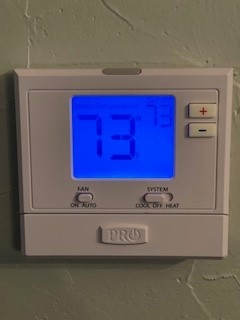The average family spends thousands of dollars every year on energy, with over 40% of those funds going to heating and cooling. That’s significant for most people—but thankfully, there are quite a few ways to cut energy costs without sacrificing comfort.
An easy strategy is to keep your thermostat setting at the right point. Even turning it back by a few degrees each day while you’re away can save up to 10% each year, according to the Department of Energy. Here, we’ll show you how to set a home’s thermostat for year-round energy (and money) savings.
Thermostat Settings for Summertime
For most homes, 72 to 73 degrees is quite comfortable. Keeping a narrower gap between indoor and outdoor temperatures will help lower summer cooling costs. While the family is at home, a setting of 78 degrees or higher will keep everyone comfortable. Here are some other tips to follow:
- Select energy-efficient window coverings such as honeycomb shades or plantation shutters.
- Keep the shades or curtains drawn during the day, which keeps cold air indoors.
- Switch ceiling fans on in occupied rooms. The Department of Energy says that the windchill effect can help a room feel up to four degrees cooler.
- If 78 degrees is still too warm, try a week-long experiment. Set the thermostat at 78 and turn it down gradually; you may be surprised at the number you can live with.
- While the family is away, there’s no need to keep the AC on. 85 degrees or higher is a great place to start. Once everyone is home, resist the temptation to turn the thermostat way down. It won’t cool the home any faster, but it will increase your power bill.
- At night, 70 degrees is good enough for most families. Energy Star suggests a setting of 82 degrees, but that can be too warm for hot summer nights.
As previously mentioned, we suggest experimenting with thermostat settings for a week or two to find the right settings for your family. On cooler nights, it may even be possible to leave the AC off and run ceiling fans instead.
Thermostat Tips for Winter Savings
During the coldest months of the year, setting the thermostat at 68 is a great way to cut heating costs while keeping everyone comfortable. As in summer, keeping a narrow gap between indoor and outdoor temperatures will keep energy spending low.
- Use insulating window treatments such as window blankets to hold heated air in.
- Open the drapes on southern windows during daylight hours and keep them drawn at night.
- Use caulking or plastic sheeting to seal drafty old windows or consider replacing them.
- Run ceiling fans in reverse to bring warm air down from the top of the room.
- If there are no pets in the home, it’s safe to set the thermostat at 50 degrees or lower during the day when everyone is away. This keeps the heating system running but minimizes the risk of frozen pipes. Don’t turn the furnace up when you come home—it won’t warm the house up any faster, but it will put unnecessary strain on the unit and increase your energy spending.
As in summertime, cooler temperatures are best at night. While the family is sleeping, keep the thermostat set at 60 to 67 degrees for maximum comfort and energy efficiency.
Other Ways to Save
There are a few other ways to lower energy spending and save money all year long. Here are some of our most common suggestions:
- Use a smart thermostat. While many homes have them, most aren’t programmed properly. Smart thermostats make it easier to monitor energy spending by learning your family’s temperature preferences and daily routine, adjusting settings to maximize savings. In most cases, it’s possible to change the thermostat’s settings from anywhere there’s an internet connection. Most smart thermostats have earned Energy Star certifications, which means local utilities may offer rebates for their installation. Ask us for additional information on these rebates and which smart thermostats are best for your local home.
- Install a more efficient HVAC system. How old is your home’s existing system? If it’s approaching the two-decade mark, consider replacing it. Reduced efficiency and mechanical failures become more common as units age. With special offers and rebates, however, replacing a home HVAC system is easier and more cost-effective than ever.
- Schedule yearly service. Routine HVAC maintenance keeps systems running well and reduces the risk of premature failure. It may increase efficiency and lengthen the system’s lifespan, because it allows our technicians to detect small issues before they turn into big and expensive ones. With our maintenance agreements, it’s easy to keep up with recommended service intervals.
- Replace the air filter regularly. Change the system’s air filter every one to three months, depending on the filter’s type and the level of dust in the air. When the filter is clogged, the system must work harder, increasing the risk of breakdowns and other problems.
- Check the insulation in the attic. Over 90% of homes in the US lack insulation, which is a primary factor in indoor comfort. Many local utilities offer rebates for the addition of insulation, so ask yours for details.
- Get the ductwork examined. In older homes, leaking ducts will affect energy spending and indoor comfort. Leaks are hard to find when ductwork is hidden, so consider hiring a professional to inspect it.
- Seal any leaks. By using weatherstripping and caulking to keep conditioned air in, you’ll spend less.
Count on Us to Keep Your Home Energy Efficient and Comfortable
At AC Tex, our team has been focused on customers’ comfort since we opened our doors. We won’t just meet your expectations; we’ll do what it takes to exceed them. Whether you’re scheduling regular maintenance or simply looking for ways to increase energy efficiency, you can count on us for fast, friendly service and helpful advice. Find out more about how our experts can make your home more efficient and comfortable by filling out our online contact form or giving us a call today.
Blake Brumfield is the owner of AC TEX, LLC Air Conditioning and Heating. He is a graduate of Lindsey-Cooper Refrigeration School and has over 6 years of working experience out in the field. Blake holds a Universal EPA License, Certified Technician License, and a HVAC Contractor License. In addition to his love of the outdoors, Blake spends most of his free time continuing to study and learn about today’s modern HVAC systems.

